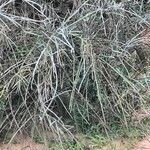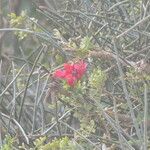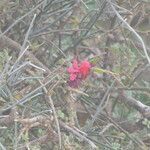Tree or shrub, 1-3 m high, leafless, branches somewhat weak, dark green often with purple bloom, glabrous. Leaves present only on seedlings and very young branches; alternate, subsessile, green, thin, drying leathery, glabrous, oblong. Flowers corymbose or racemose, pedicellate. Sepals 4, yellowish green, orange or dark red, free, decussate. Petals absent. Stamens usually 8. Ovary cylindric. Flowering time all year. Fruit cylindric, verrucose, glabrous to glandular. Seeds embedded in a powdery matrix, reniform, with verrucose, black to brown testa.
Leafless, spinescent shrub or small tree, up to 2(-3) m tall, often with fleshy purple-tinged branches. Leaves short-lived, present only on seedlings. Flowers usually in short, flat-topped heads, yellowish to dark red, bearing stamens and style on a well-exserted stalk. Fruit cylindrical, 50-90 x 6-7 mm, smooth or densely glandular. Flowering Aug.-Nov.(-Apr.).
Shrub or small tree, up to 3 m high. Branches becoming spine-tipped, sometimes subsucculent. Leaves 0, except on young branches. Flowers: stamens 8 or more; nectary hooded or saucershaped, with no conspicuous neck; perianth 20-30 mm in diameter, yellowish green, orange or dark red; Aug.-Jan. Fruit cylindrical, up to 90 x 7 mm, warty with sticky glands.
Sepals 4, yellow or reddish-purple, 1–1.7 x 0.7–1 cm., the lowest rather larger than the remainder, connate at the base into a very shallow receptacle c. 1 mm. in depth, broadly elliptic, obtuse at the apex, with capitate, glandular hairs densely or sparsely scattered on both sides.
Shrub or small tree, up to 3 m high. Leaves absent, except on young branches. Stamens 8 or more. Nectary hooded or saucer-shaped, with no conspicuous neck. Sepals yellowish green, orange or dark red.
Flowers in short, corymbose, axillary racemes; rhachis 0.3–2.3 cm. long, glabrous or glandular-pubescent; bracts subulate, c. 1 mm. long; pedicels glabrous or glandular-pubescent, up to 1.3 cm. long.
Leafless, twiggy shrub to 2 m. tall; branches rather virgate, stiff, smooth, green or glaucous with subspinous apices, glabrous, young branches with subulate leaf scales up to 2 mm. long.
Leafless often tangled shrub with purplish branches to 2 m. Flowers in corymbs or racemes on side shoots, greenish to red.
Ovary narrowly cylindric, glabrous or glandular-pubescent; ovules numerous, on 2 placentas; stigma capitate, sessile.
Androgynophore 2.5–3 mm. long, glabrous, shallowly declinate with a hooded nectary at its base c. 4 mm. broad.
Fruit up to 8 x 0.4 cm., cylindric, subtorulose, glandular or minutely verrucose, many-seeded.
Stamens 8; filaments 1 cm. long; anthers 2.3 x 0.75 mm., oblong.
Gynophore c. 1 cm. long, glabrous or glandular-pubescent.
Seeds brown, c. 0.3 cm. in diam., subglobose.
Petals 0.




